Financial Performance Evaluation of DP World and PSA Internationals
VerifiedAdded on 2023/06/10
|14
|3285
|490
AI Summary
This report evaluates the financial performance of DP World and PSA Internationals using key financial ratios such as profitability, solvency, efficiency and capital structure. The report includes the computation of key financial ratios, analysis of the same and cross-sectional analysis with industry averages.
Contribute Materials
Your contribution can guide someone’s learning journey. Share your
documents today.
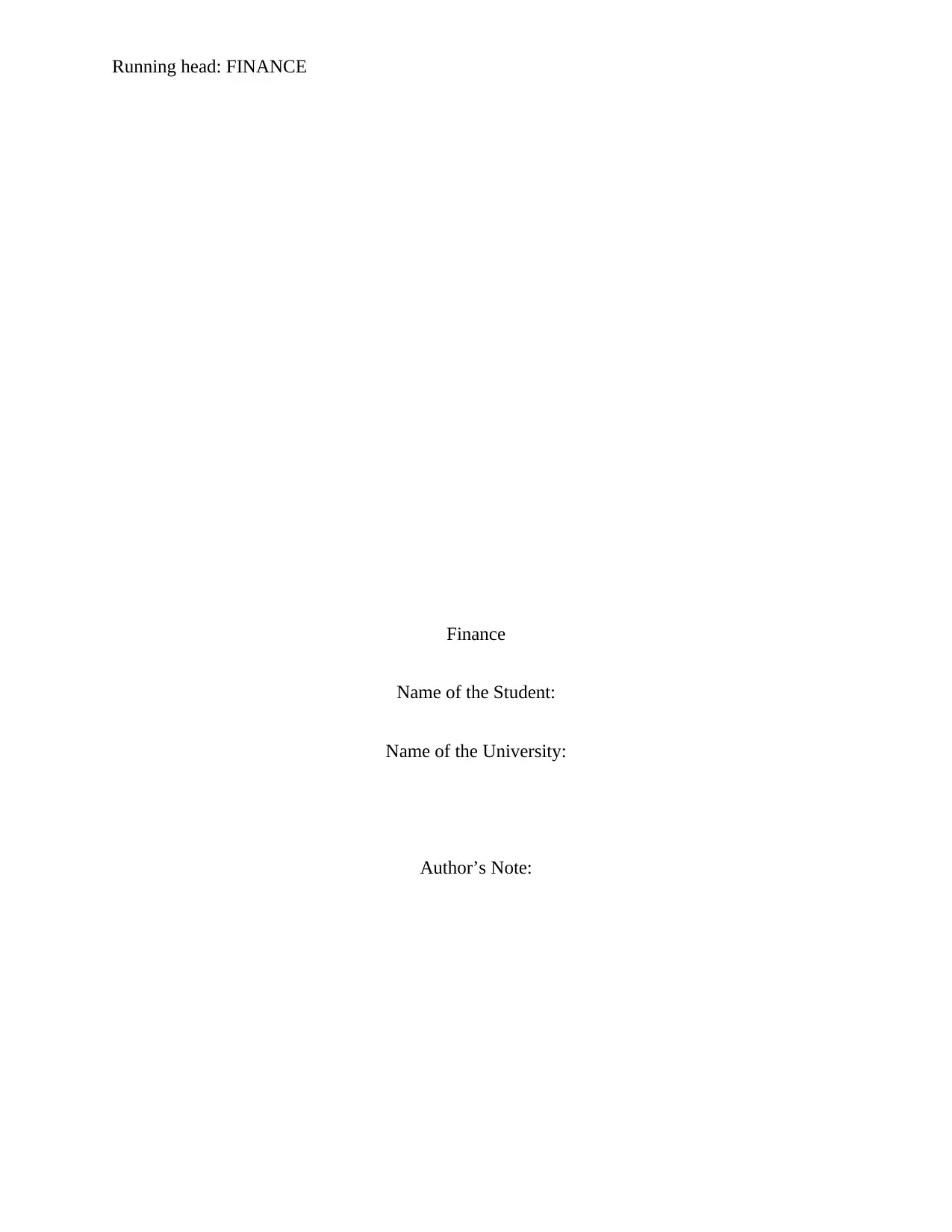
Running head: FINANCE
Finance
Name of the Student:
Name of the University:
Author’s Note:
Finance
Name of the Student:
Name of the University:
Author’s Note:
Secure Best Marks with AI Grader
Need help grading? Try our AI Grader for instant feedback on your assignments.
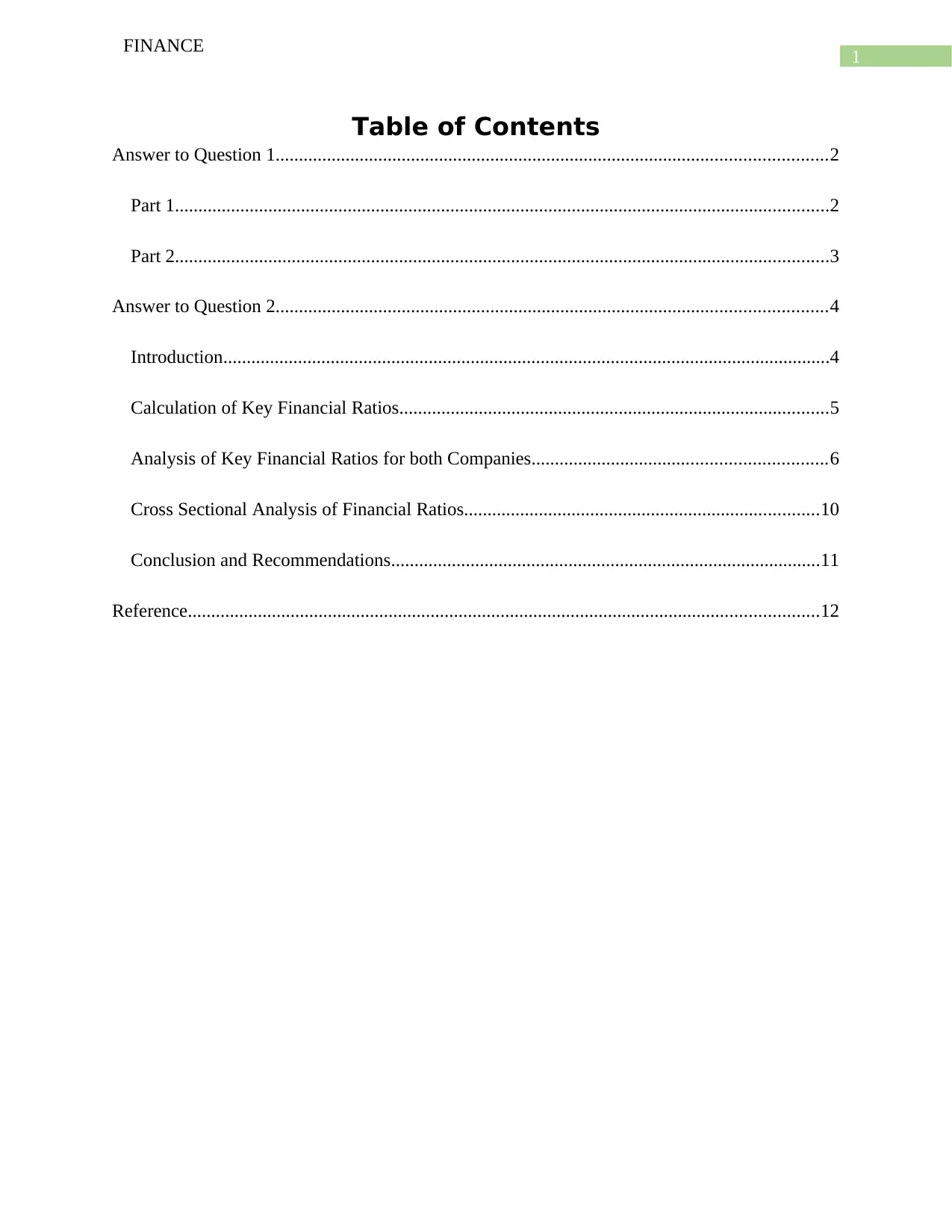
1
FINANCE
Table of Contents
Answer to Question 1......................................................................................................................2
Part 1............................................................................................................................................2
Part 2............................................................................................................................................3
Answer to Question 2......................................................................................................................4
Introduction..................................................................................................................................4
Calculation of Key Financial Ratios............................................................................................5
Analysis of Key Financial Ratios for both Companies...............................................................6
Cross Sectional Analysis of Financial Ratios............................................................................10
Conclusion and Recommendations............................................................................................11
Reference.......................................................................................................................................12
FINANCE
Table of Contents
Answer to Question 1......................................................................................................................2
Part 1............................................................................................................................................2
Part 2............................................................................................................................................3
Answer to Question 2......................................................................................................................4
Introduction..................................................................................................................................4
Calculation of Key Financial Ratios............................................................................................5
Analysis of Key Financial Ratios for both Companies...............................................................6
Cross Sectional Analysis of Financial Ratios............................................................................10
Conclusion and Recommendations............................................................................................11
Reference.......................................................................................................................................12
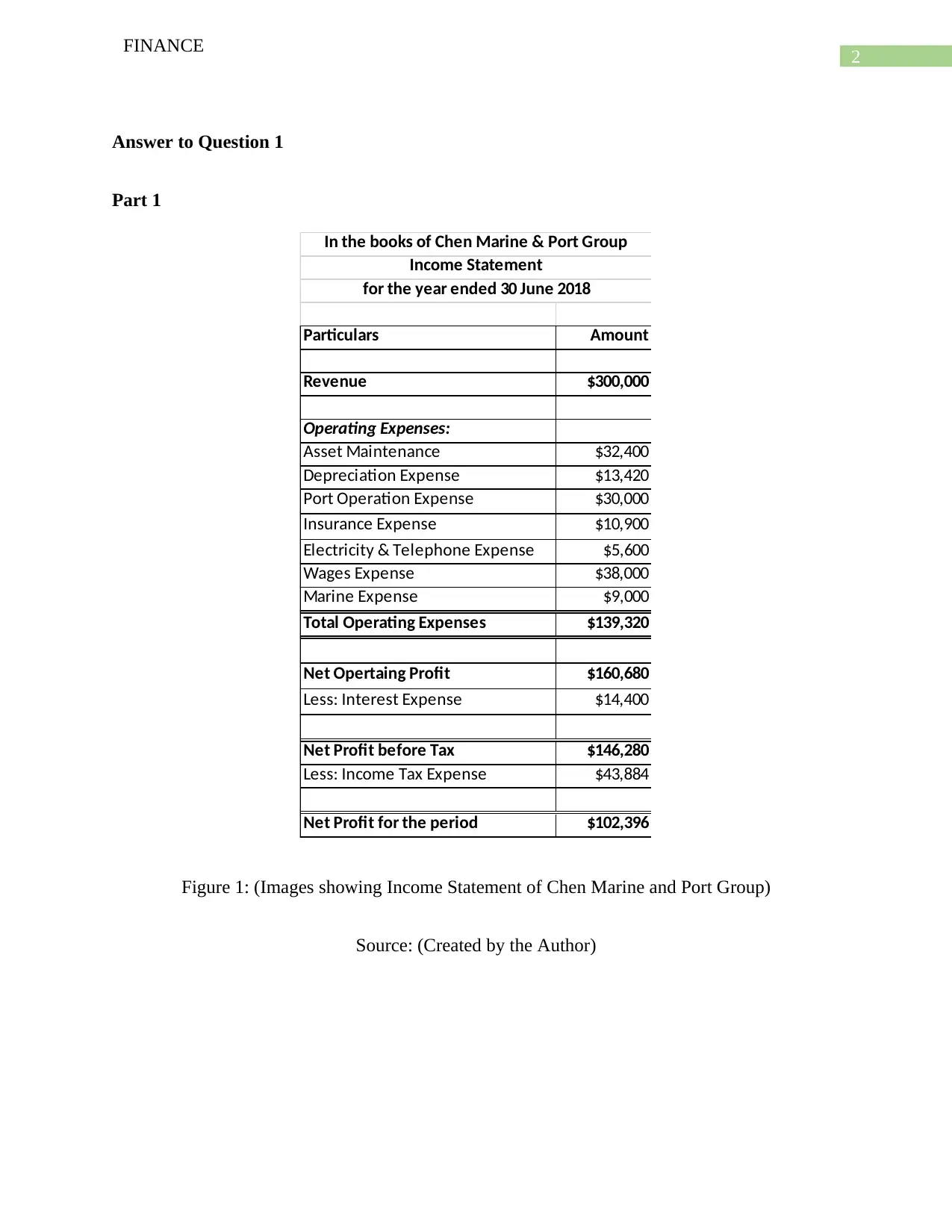
2
FINANCE
Answer to Question 1
Part 1
Particulars Amount
Revenue $300,000
Operating Expenses:
Asset Maintenance $32,400
Depreciation Expense $13,420
Port Operation Expense $30,000
Insurance Expense $10,900
Electricity & Telephone Expense $5,600
Wages Expense $38,000
Marine Expense $9,000
Total Operating Expenses $139,320
Net Opertaing Profit $160,680
Less: Interest Expense $14,400
Net Profit before Tax $146,280
Less: Income Tax Expense $43,884
Net Profit for the period $102,396
In the books of Chen Marine & Port Group
Income Statement
for the year ended 30 June 2018
Figure 1: (Images showing Income Statement of Chen Marine and Port Group)
Source: (Created by the Author)
FINANCE
Answer to Question 1
Part 1
Particulars Amount
Revenue $300,000
Operating Expenses:
Asset Maintenance $32,400
Depreciation Expense $13,420
Port Operation Expense $30,000
Insurance Expense $10,900
Electricity & Telephone Expense $5,600
Wages Expense $38,000
Marine Expense $9,000
Total Operating Expenses $139,320
Net Opertaing Profit $160,680
Less: Interest Expense $14,400
Net Profit before Tax $146,280
Less: Income Tax Expense $43,884
Net Profit for the period $102,396
In the books of Chen Marine & Port Group
Income Statement
for the year ended 30 June 2018
Figure 1: (Images showing Income Statement of Chen Marine and Port Group)
Source: (Created by the Author)
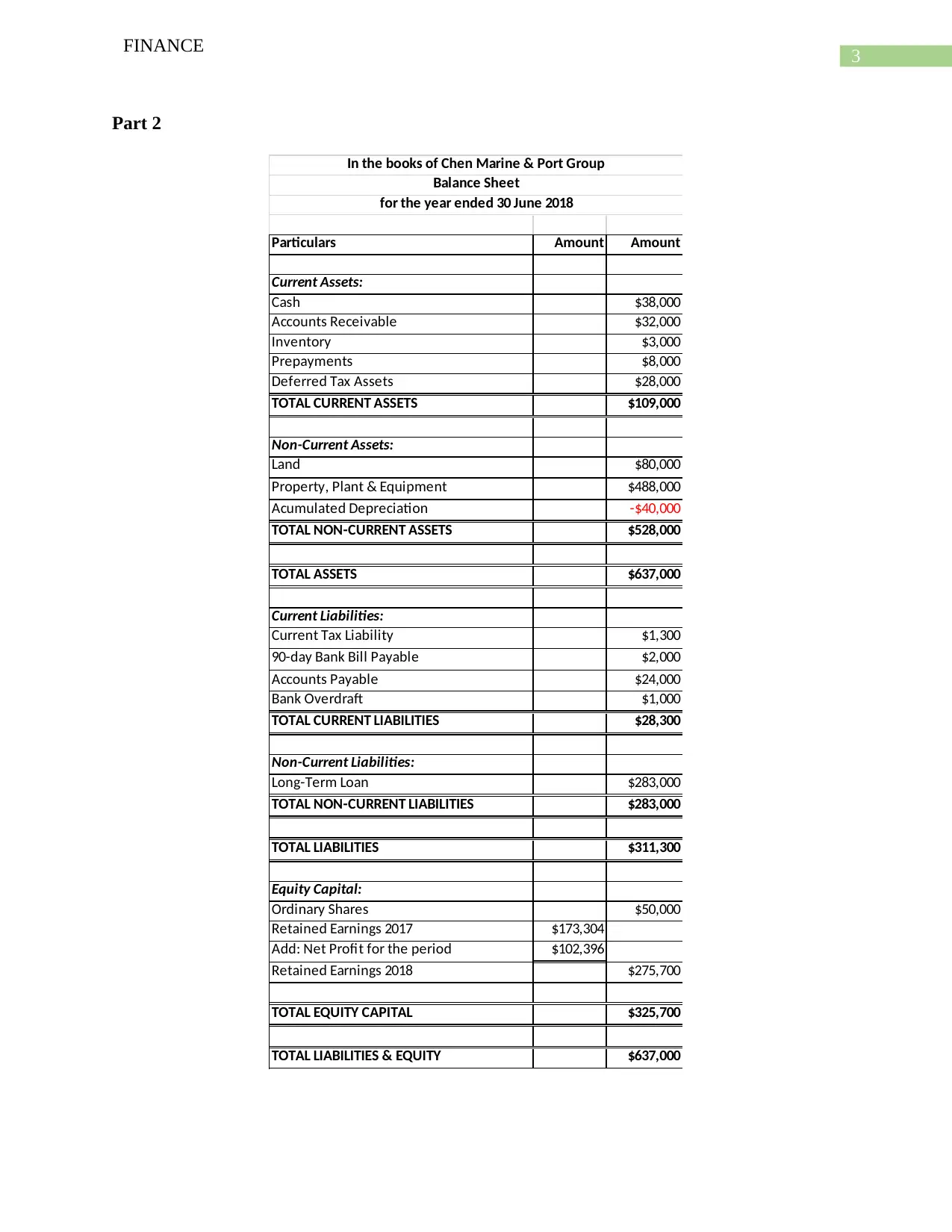
3
FINANCE
Part 2
Particulars Amount Amount
Current Assets:
Cash $38,000
Accounts Receivable $32,000
Inventory $3,000
Prepayments $8,000
Deferred Tax Assets $28,000
TOTAL CURRENT ASSETS $109,000
Non-Current Assets:
Land $80,000
Property, Plant & Equipment $488,000
Acumulated Depreciation -$40,000
TOTAL NON-CURRENT ASSETS $528,000
TOTAL ASSETS $637,000
Current Liabilities:
Current Tax Liability $1,300
90-day Bank Bill Payable $2,000
Accounts Payable $24,000
Bank Overdraft $1,000
TOTAL CURRENT LIABILITIES $28,300
Non-Current Liabilities:
Long-Term Loan $283,000
TOTAL NON-CURRENT LIABILITIES $283,000
TOTAL LIABILITIES $311,300
Equity Capital:
Ordinary Shares $50,000
Retained Earnings 2017 $173,304
Add: Net Profit for the period $102,396
Retained Earnings 2018 $275,700
TOTAL EQUITY CAPITAL $325,700
TOTAL LIABILITIES & EQUITY $637,000
In the books of Chen Marine & Port Group
Balance Sheet
for the year ended 30 June 2018
FINANCE
Part 2
Particulars Amount Amount
Current Assets:
Cash $38,000
Accounts Receivable $32,000
Inventory $3,000
Prepayments $8,000
Deferred Tax Assets $28,000
TOTAL CURRENT ASSETS $109,000
Non-Current Assets:
Land $80,000
Property, Plant & Equipment $488,000
Acumulated Depreciation -$40,000
TOTAL NON-CURRENT ASSETS $528,000
TOTAL ASSETS $637,000
Current Liabilities:
Current Tax Liability $1,300
90-day Bank Bill Payable $2,000
Accounts Payable $24,000
Bank Overdraft $1,000
TOTAL CURRENT LIABILITIES $28,300
Non-Current Liabilities:
Long-Term Loan $283,000
TOTAL NON-CURRENT LIABILITIES $283,000
TOTAL LIABILITIES $311,300
Equity Capital:
Ordinary Shares $50,000
Retained Earnings 2017 $173,304
Add: Net Profit for the period $102,396
Retained Earnings 2018 $275,700
TOTAL EQUITY CAPITAL $325,700
TOTAL LIABILITIES & EQUITY $637,000
In the books of Chen Marine & Port Group
Balance Sheet
for the year ended 30 June 2018
Secure Best Marks with AI Grader
Need help grading? Try our AI Grader for instant feedback on your assignments.

4
FINANCE
Figure 2: (Images showing Balance Sheet of Chen Marine and Port Group)
Source: (Created by the Author)
Answer to Question 2
Introduction
The primary objective of this report is to evaluate the financial performance of two
companies which are DP World and PSA Internationals. The report will be including key
financial ratios and analyzing the same for the purpose of identifying different areas of
performance for the businesses such as profitability, solvency, efficiency and capital structure.
DP World is engaged in the business of operating ports and was established in the year
2005 by merging of Dubai Ports Authority and Dubai Ports International. The company had
purchased numerous ports in USA but the same were sold shortly afterwards due to the
controversy which arose. PSA Internationals is also in engaged in the operations of port
operations and is considered to be one of the largest port operators of the country. The
assessment will be considering the financial information of these companies from the annual
report for recent years for computing key financial ratios of the business.
FINANCE
Figure 2: (Images showing Balance Sheet of Chen Marine and Port Group)
Source: (Created by the Author)
Answer to Question 2
Introduction
The primary objective of this report is to evaluate the financial performance of two
companies which are DP World and PSA Internationals. The report will be including key
financial ratios and analyzing the same for the purpose of identifying different areas of
performance for the businesses such as profitability, solvency, efficiency and capital structure.
DP World is engaged in the business of operating ports and was established in the year
2005 by merging of Dubai Ports Authority and Dubai Ports International. The company had
purchased numerous ports in USA but the same were sold shortly afterwards due to the
controversy which arose. PSA Internationals is also in engaged in the operations of port
operations and is considered to be one of the largest port operators of the country. The
assessment will be considering the financial information of these companies from the annual
report for recent years for computing key financial ratios of the business.
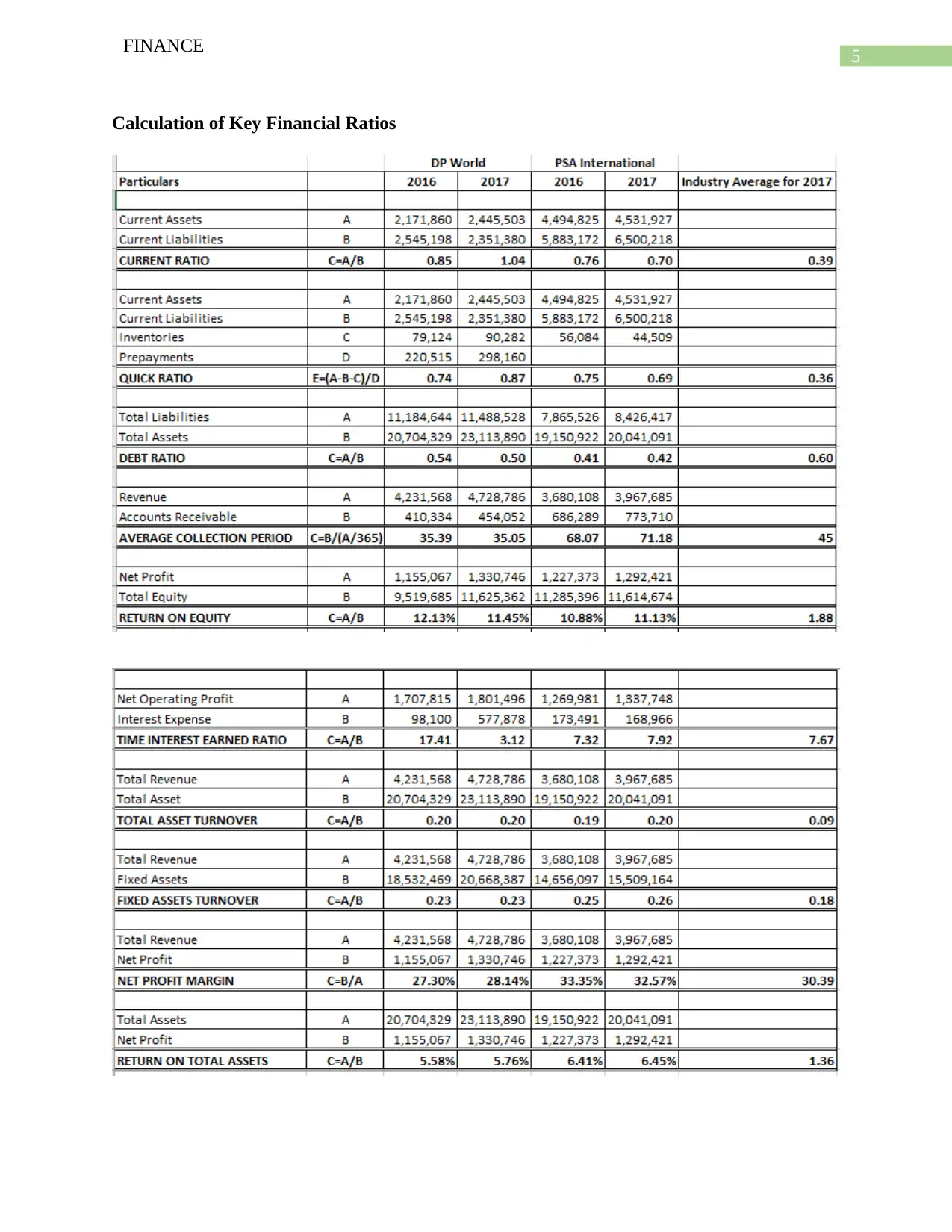
5
FINANCE
Calculation of Key Financial Ratios
FINANCE
Calculation of Key Financial Ratios
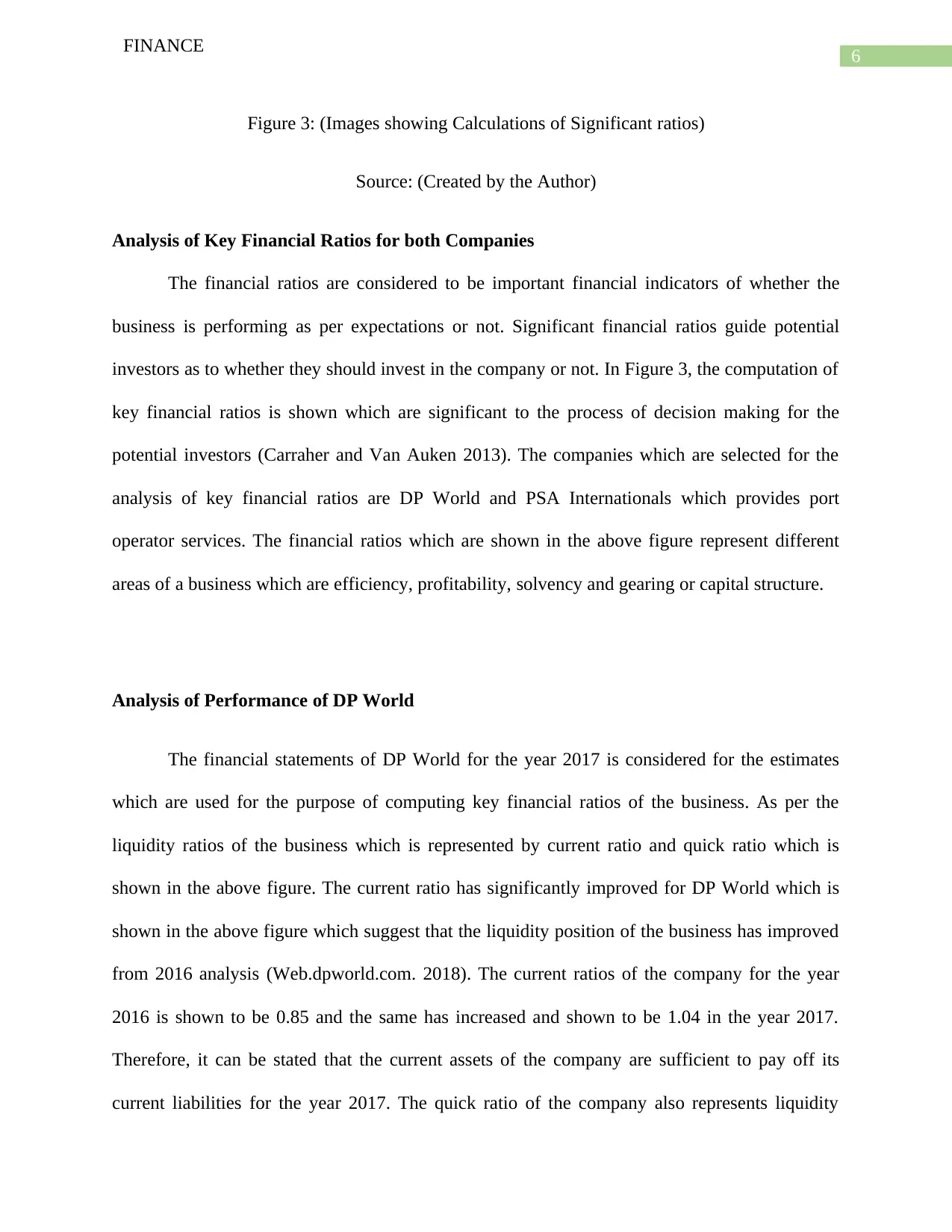
6
FINANCE
Figure 3: (Images showing Calculations of Significant ratios)
Source: (Created by the Author)
Analysis of Key Financial Ratios for both Companies
The financial ratios are considered to be important financial indicators of whether the
business is performing as per expectations or not. Significant financial ratios guide potential
investors as to whether they should invest in the company or not. In Figure 3, the computation of
key financial ratios is shown which are significant to the process of decision making for the
potential investors (Carraher and Van Auken 2013). The companies which are selected for the
analysis of key financial ratios are DP World and PSA Internationals which provides port
operator services. The financial ratios which are shown in the above figure represent different
areas of a business which are efficiency, profitability, solvency and gearing or capital structure.
Analysis of Performance of DP World
The financial statements of DP World for the year 2017 is considered for the estimates
which are used for the purpose of computing key financial ratios of the business. As per the
liquidity ratios of the business which is represented by current ratio and quick ratio which is
shown in the above figure. The current ratio has significantly improved for DP World which is
shown in the above figure which suggest that the liquidity position of the business has improved
from 2016 analysis (Web.dpworld.com. 2018). The current ratios of the company for the year
2016 is shown to be 0.85 and the same has increased and shown to be 1.04 in the year 2017.
Therefore, it can be stated that the current assets of the company are sufficient to pay off its
current liabilities for the year 2017. The quick ratio of the company also represents liquidity
FINANCE
Figure 3: (Images showing Calculations of Significant ratios)
Source: (Created by the Author)
Analysis of Key Financial Ratios for both Companies
The financial ratios are considered to be important financial indicators of whether the
business is performing as per expectations or not. Significant financial ratios guide potential
investors as to whether they should invest in the company or not. In Figure 3, the computation of
key financial ratios is shown which are significant to the process of decision making for the
potential investors (Carraher and Van Auken 2013). The companies which are selected for the
analysis of key financial ratios are DP World and PSA Internationals which provides port
operator services. The financial ratios which are shown in the above figure represent different
areas of a business which are efficiency, profitability, solvency and gearing or capital structure.
Analysis of Performance of DP World
The financial statements of DP World for the year 2017 is considered for the estimates
which are used for the purpose of computing key financial ratios of the business. As per the
liquidity ratios of the business which is represented by current ratio and quick ratio which is
shown in the above figure. The current ratio has significantly improved for DP World which is
shown in the above figure which suggest that the liquidity position of the business has improved
from 2016 analysis (Web.dpworld.com. 2018). The current ratios of the company for the year
2016 is shown to be 0.85 and the same has increased and shown to be 1.04 in the year 2017.
Therefore, it can be stated that the current assets of the company are sufficient to pay off its
current liabilities for the year 2017. The quick ratio of the company also represents liquidity
Paraphrase This Document
Need a fresh take? Get an instant paraphrase of this document with our AI Paraphraser
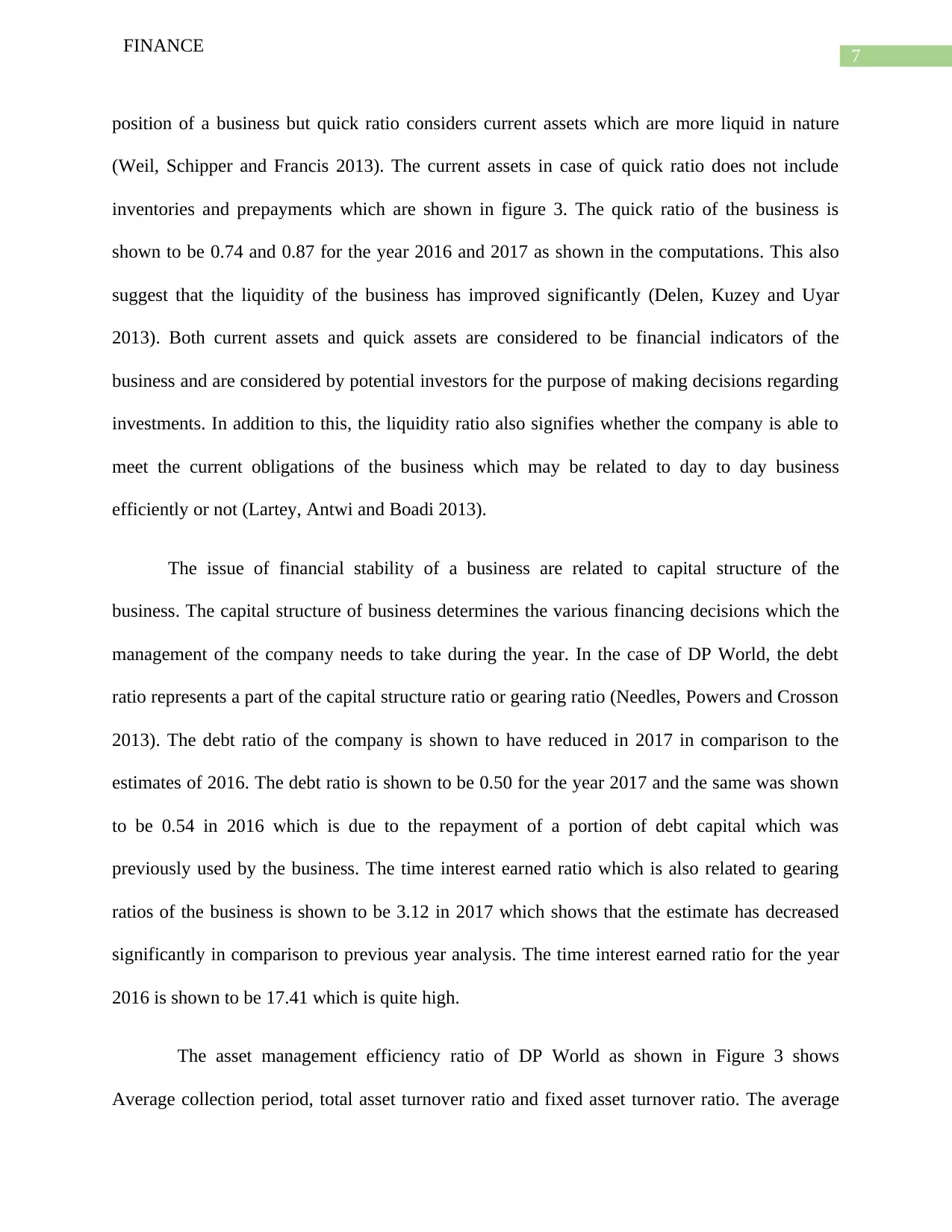
7
FINANCE
position of a business but quick ratio considers current assets which are more liquid in nature
(Weil, Schipper and Francis 2013). The current assets in case of quick ratio does not include
inventories and prepayments which are shown in figure 3. The quick ratio of the business is
shown to be 0.74 and 0.87 for the year 2016 and 2017 as shown in the computations. This also
suggest that the liquidity of the business has improved significantly (Delen, Kuzey and Uyar
2013). Both current assets and quick assets are considered to be financial indicators of the
business and are considered by potential investors for the purpose of making decisions regarding
investments. In addition to this, the liquidity ratio also signifies whether the company is able to
meet the current obligations of the business which may be related to day to day business
efficiently or not (Lartey, Antwi and Boadi 2013).
The issue of financial stability of a business are related to capital structure of the
business. The capital structure of business determines the various financing decisions which the
management of the company needs to take during the year. In the case of DP World, the debt
ratio represents a part of the capital structure ratio or gearing ratio (Needles, Powers and Crosson
2013). The debt ratio of the company is shown to have reduced in 2017 in comparison to the
estimates of 2016. The debt ratio is shown to be 0.50 for the year 2017 and the same was shown
to be 0.54 in 2016 which is due to the repayment of a portion of debt capital which was
previously used by the business. The time interest earned ratio which is also related to gearing
ratios of the business is shown to be 3.12 in 2017 which shows that the estimate has decreased
significantly in comparison to previous year analysis. The time interest earned ratio for the year
2016 is shown to be 17.41 which is quite high.
The asset management efficiency ratio of DP World as shown in Figure 3 shows
Average collection period, total asset turnover ratio and fixed asset turnover ratio. The average
FINANCE
position of a business but quick ratio considers current assets which are more liquid in nature
(Weil, Schipper and Francis 2013). The current assets in case of quick ratio does not include
inventories and prepayments which are shown in figure 3. The quick ratio of the business is
shown to be 0.74 and 0.87 for the year 2016 and 2017 as shown in the computations. This also
suggest that the liquidity of the business has improved significantly (Delen, Kuzey and Uyar
2013). Both current assets and quick assets are considered to be financial indicators of the
business and are considered by potential investors for the purpose of making decisions regarding
investments. In addition to this, the liquidity ratio also signifies whether the company is able to
meet the current obligations of the business which may be related to day to day business
efficiently or not (Lartey, Antwi and Boadi 2013).
The issue of financial stability of a business are related to capital structure of the
business. The capital structure of business determines the various financing decisions which the
management of the company needs to take during the year. In the case of DP World, the debt
ratio represents a part of the capital structure ratio or gearing ratio (Needles, Powers and Crosson
2013). The debt ratio of the company is shown to have reduced in 2017 in comparison to the
estimates of 2016. The debt ratio is shown to be 0.50 for the year 2017 and the same was shown
to be 0.54 in 2016 which is due to the repayment of a portion of debt capital which was
previously used by the business. The time interest earned ratio which is also related to gearing
ratios of the business is shown to be 3.12 in 2017 which shows that the estimate has decreased
significantly in comparison to previous year analysis. The time interest earned ratio for the year
2016 is shown to be 17.41 which is quite high.
The asset management efficiency ratio of DP World as shown in Figure 3 shows
Average collection period, total asset turnover ratio and fixed asset turnover ratio. The average
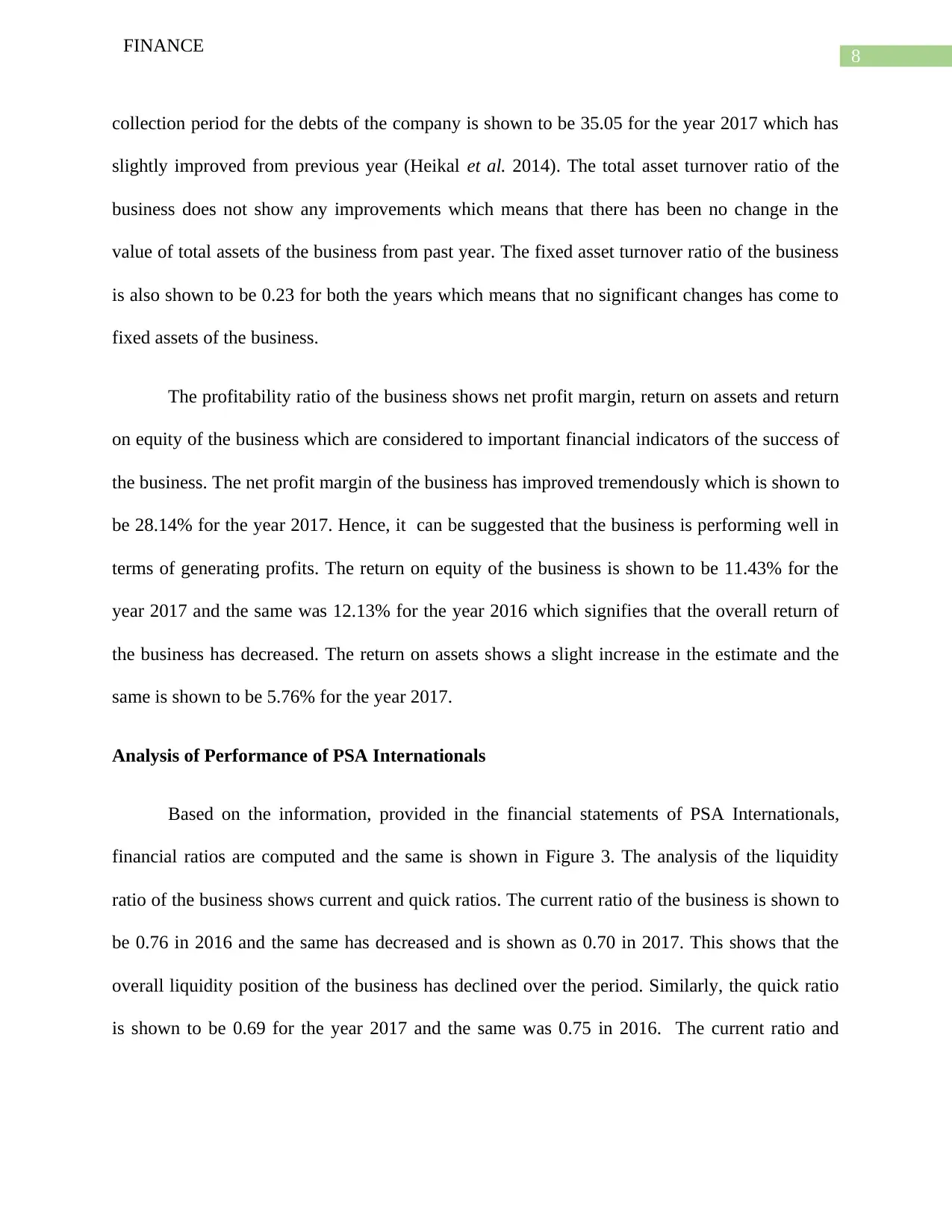
8
FINANCE
collection period for the debts of the company is shown to be 35.05 for the year 2017 which has
slightly improved from previous year (Heikal et al. 2014). The total asset turnover ratio of the
business does not show any improvements which means that there has been no change in the
value of total assets of the business from past year. The fixed asset turnover ratio of the business
is also shown to be 0.23 for both the years which means that no significant changes has come to
fixed assets of the business.
The profitability ratio of the business shows net profit margin, return on assets and return
on equity of the business which are considered to important financial indicators of the success of
the business. The net profit margin of the business has improved tremendously which is shown to
be 28.14% for the year 2017. Hence, it can be suggested that the business is performing well in
terms of generating profits. The return on equity of the business is shown to be 11.43% for the
year 2017 and the same was 12.13% for the year 2016 which signifies that the overall return of
the business has decreased. The return on assets shows a slight increase in the estimate and the
same is shown to be 5.76% for the year 2017.
Analysis of Performance of PSA Internationals
Based on the information, provided in the financial statements of PSA Internationals,
financial ratios are computed and the same is shown in Figure 3. The analysis of the liquidity
ratio of the business shows current and quick ratios. The current ratio of the business is shown to
be 0.76 in 2016 and the same has decreased and is shown as 0.70 in 2017. This shows that the
overall liquidity position of the business has declined over the period. Similarly, the quick ratio
is shown to be 0.69 for the year 2017 and the same was 0.75 in 2016. The current ratio and
FINANCE
collection period for the debts of the company is shown to be 35.05 for the year 2017 which has
slightly improved from previous year (Heikal et al. 2014). The total asset turnover ratio of the
business does not show any improvements which means that there has been no change in the
value of total assets of the business from past year. The fixed asset turnover ratio of the business
is also shown to be 0.23 for both the years which means that no significant changes has come to
fixed assets of the business.
The profitability ratio of the business shows net profit margin, return on assets and return
on equity of the business which are considered to important financial indicators of the success of
the business. The net profit margin of the business has improved tremendously which is shown to
be 28.14% for the year 2017. Hence, it can be suggested that the business is performing well in
terms of generating profits. The return on equity of the business is shown to be 11.43% for the
year 2017 and the same was 12.13% for the year 2016 which signifies that the overall return of
the business has decreased. The return on assets shows a slight increase in the estimate and the
same is shown to be 5.76% for the year 2017.
Analysis of Performance of PSA Internationals
Based on the information, provided in the financial statements of PSA Internationals,
financial ratios are computed and the same is shown in Figure 3. The analysis of the liquidity
ratio of the business shows current and quick ratios. The current ratio of the business is shown to
be 0.76 in 2016 and the same has decreased and is shown as 0.70 in 2017. This shows that the
overall liquidity position of the business has declined over the period. Similarly, the quick ratio
is shown to be 0.69 for the year 2017 and the same was 0.75 in 2016. The current ratio and

9
FINANCE
quick ratio of the business both shows decrease which suggest that the liquidity position of the
business has decreased slightly (Globalpsa.com. 2018).
The gearing ratio of the business is showing debt of the business and also has equity
capital in the capital mix of the business. The debt ratio of the business has increased to 0.42 in
2017 and the same is shown to be 0.41 in 2016. The debt ratio suggest that the borrowings of the
business has increased in the current year. The Time interest earned ratio of the business for the
year 2017 is shown to be 7.92 which is more than previous year estimate (Al Karim and Alam
2013). Therefore, this signifies that the business has taken additional loan for financing the
activities of the business.
The asset management ratios signifies that the efficiency of the business to manage the
return which can be generated. The average collection period which is computed in figure 3
shows that the same has become higher which is not acceptable for the company. This signifies
that the funds of the business will be blocked for additional number of days. The total asset
turnover ratio and fixed asset turnover ratio shows that both have increased slightly from the
estimates of previous year which is represent that the company has made certain additions to the
assets of the business during the year.
The profitability ratio of the company shows net profit margin, return on assets and return
on equity for the business. All three of these ratios are considered to be financial indicators of the
success of the business (Louis, Seret and Baesens 2013). The net profit margin of the company is
shown to be 32.57% which is significant lower than the estimate of 2016 which is shown to be
33.35%. This shows that there is a fall in the profits of the business. It is an unfavorable sign for
the business. The return on equity, generated by the business is shown to be higher in 2017
FINANCE
quick ratio of the business both shows decrease which suggest that the liquidity position of the
business has decreased slightly (Globalpsa.com. 2018).
The gearing ratio of the business is showing debt of the business and also has equity
capital in the capital mix of the business. The debt ratio of the business has increased to 0.42 in
2017 and the same is shown to be 0.41 in 2016. The debt ratio suggest that the borrowings of the
business has increased in the current year. The Time interest earned ratio of the business for the
year 2017 is shown to be 7.92 which is more than previous year estimate (Al Karim and Alam
2013). Therefore, this signifies that the business has taken additional loan for financing the
activities of the business.
The asset management ratios signifies that the efficiency of the business to manage the
return which can be generated. The average collection period which is computed in figure 3
shows that the same has become higher which is not acceptable for the company. This signifies
that the funds of the business will be blocked for additional number of days. The total asset
turnover ratio and fixed asset turnover ratio shows that both have increased slightly from the
estimates of previous year which is represent that the company has made certain additions to the
assets of the business during the year.
The profitability ratio of the company shows net profit margin, return on assets and return
on equity for the business. All three of these ratios are considered to be financial indicators of the
success of the business (Louis, Seret and Baesens 2013). The net profit margin of the company is
shown to be 32.57% which is significant lower than the estimate of 2016 which is shown to be
33.35%. This shows that there is a fall in the profits of the business. It is an unfavorable sign for
the business. The return on equity, generated by the business is shown to be higher in 2017
Secure Best Marks with AI Grader
Need help grading? Try our AI Grader for instant feedback on your assignments.
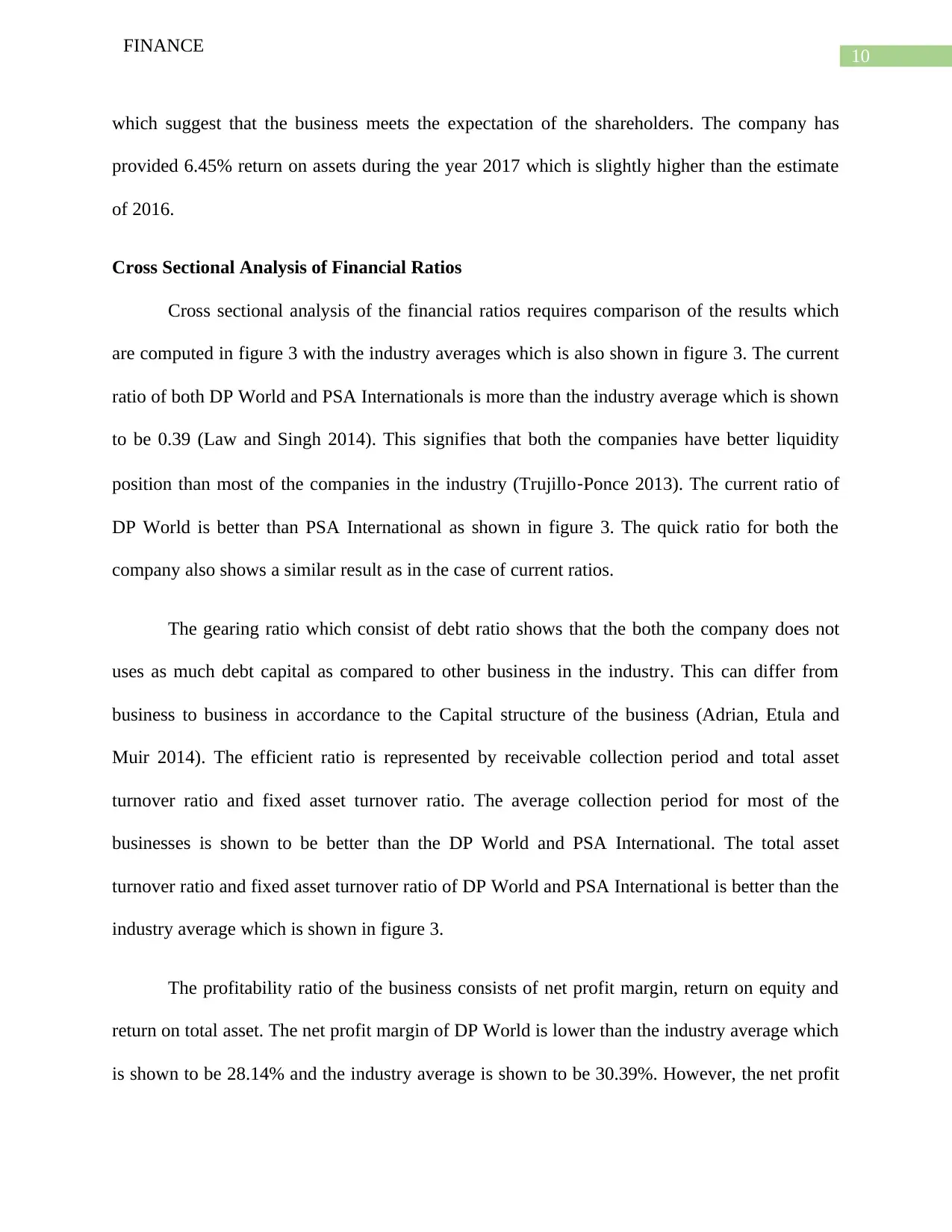
10
FINANCE
which suggest that the business meets the expectation of the shareholders. The company has
provided 6.45% return on assets during the year 2017 which is slightly higher than the estimate
of 2016.
Cross Sectional Analysis of Financial Ratios
Cross sectional analysis of the financial ratios requires comparison of the results which
are computed in figure 3 with the industry averages which is also shown in figure 3. The current
ratio of both DP World and PSA Internationals is more than the industry average which is shown
to be 0.39 (Law and Singh 2014). This signifies that both the companies have better liquidity
position than most of the companies in the industry (Trujillo‐Ponce 2013). The current ratio of
DP World is better than PSA International as shown in figure 3. The quick ratio for both the
company also shows a similar result as in the case of current ratios.
The gearing ratio which consist of debt ratio shows that the both the company does not
uses as much debt capital as compared to other business in the industry. This can differ from
business to business in accordance to the Capital structure of the business (Adrian, Etula and
Muir 2014). The efficient ratio is represented by receivable collection period and total asset
turnover ratio and fixed asset turnover ratio. The average collection period for most of the
businesses is shown to be better than the DP World and PSA International. The total asset
turnover ratio and fixed asset turnover ratio of DP World and PSA International is better than the
industry average which is shown in figure 3.
The profitability ratio of the business consists of net profit margin, return on equity and
return on total asset. The net profit margin of DP World is lower than the industry average which
is shown to be 28.14% and the industry average is shown to be 30.39%. However, the net profit
FINANCE
which suggest that the business meets the expectation of the shareholders. The company has
provided 6.45% return on assets during the year 2017 which is slightly higher than the estimate
of 2016.
Cross Sectional Analysis of Financial Ratios
Cross sectional analysis of the financial ratios requires comparison of the results which
are computed in figure 3 with the industry averages which is also shown in figure 3. The current
ratio of both DP World and PSA Internationals is more than the industry average which is shown
to be 0.39 (Law and Singh 2014). This signifies that both the companies have better liquidity
position than most of the companies in the industry (Trujillo‐Ponce 2013). The current ratio of
DP World is better than PSA International as shown in figure 3. The quick ratio for both the
company also shows a similar result as in the case of current ratios.
The gearing ratio which consist of debt ratio shows that the both the company does not
uses as much debt capital as compared to other business in the industry. This can differ from
business to business in accordance to the Capital structure of the business (Adrian, Etula and
Muir 2014). The efficient ratio is represented by receivable collection period and total asset
turnover ratio and fixed asset turnover ratio. The average collection period for most of the
businesses is shown to be better than the DP World and PSA International. The total asset
turnover ratio and fixed asset turnover ratio of DP World and PSA International is better than the
industry average which is shown in figure 3.
The profitability ratio of the business consists of net profit margin, return on equity and
return on total asset. The net profit margin of DP World is lower than the industry average which
is shown to be 28.14% and the industry average is shown to be 30.39%. However, the net profit
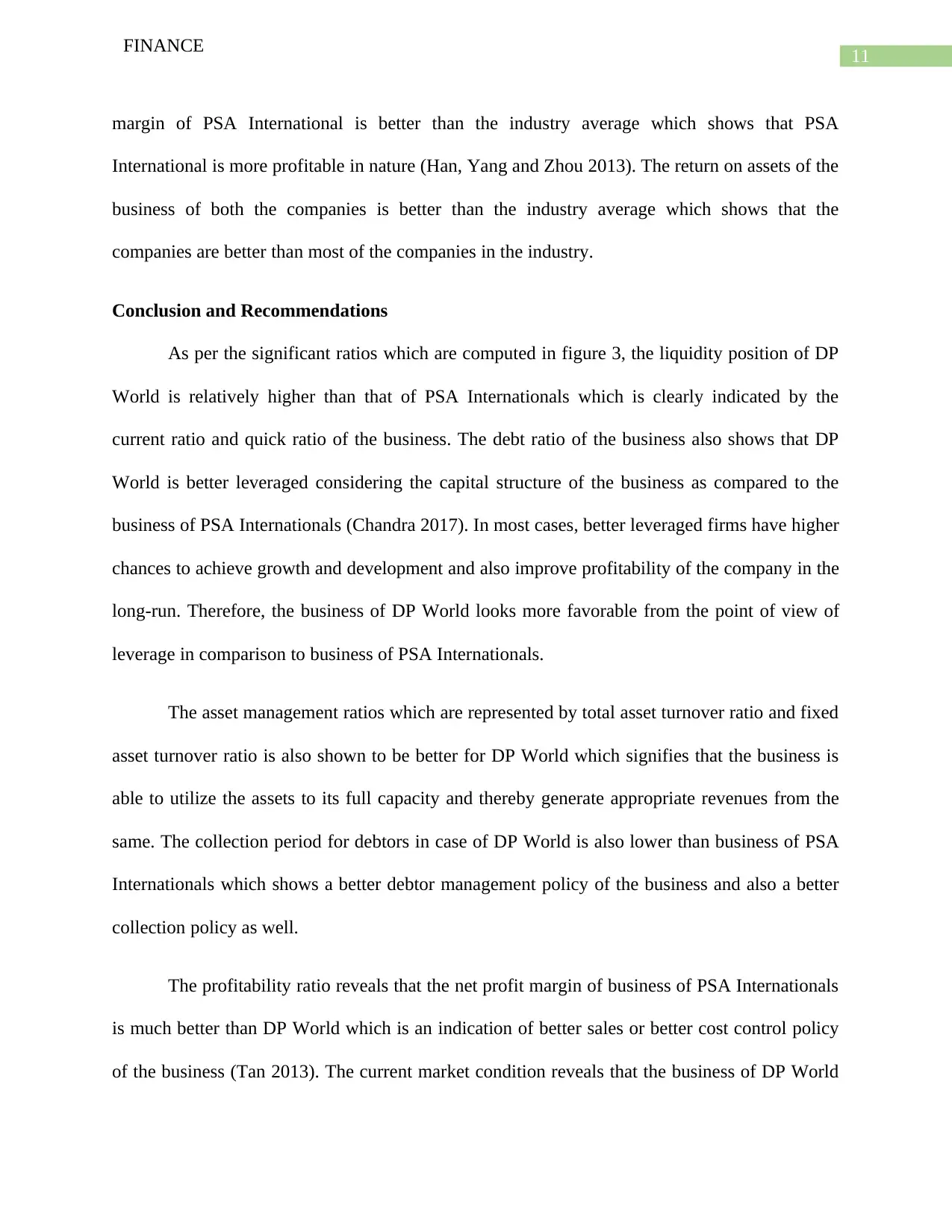
11
FINANCE
margin of PSA International is better than the industry average which shows that PSA
International is more profitable in nature (Han, Yang and Zhou 2013). The return on assets of the
business of both the companies is better than the industry average which shows that the
companies are better than most of the companies in the industry.
Conclusion and Recommendations
As per the significant ratios which are computed in figure 3, the liquidity position of DP
World is relatively higher than that of PSA Internationals which is clearly indicated by the
current ratio and quick ratio of the business. The debt ratio of the business also shows that DP
World is better leveraged considering the capital structure of the business as compared to the
business of PSA Internationals (Chandra 2017). In most cases, better leveraged firms have higher
chances to achieve growth and development and also improve profitability of the company in the
long-run. Therefore, the business of DP World looks more favorable from the point of view of
leverage in comparison to business of PSA Internationals.
The asset management ratios which are represented by total asset turnover ratio and fixed
asset turnover ratio is also shown to be better for DP World which signifies that the business is
able to utilize the assets to its full capacity and thereby generate appropriate revenues from the
same. The collection period for debtors in case of DP World is also lower than business of PSA
Internationals which shows a better debtor management policy of the business and also a better
collection policy as well.
The profitability ratio reveals that the net profit margin of business of PSA Internationals
is much better than DP World which is an indication of better sales or better cost control policy
of the business (Tan 2013). The current market condition reveals that the business of DP World
FINANCE
margin of PSA International is better than the industry average which shows that PSA
International is more profitable in nature (Han, Yang and Zhou 2013). The return on assets of the
business of both the companies is better than the industry average which shows that the
companies are better than most of the companies in the industry.
Conclusion and Recommendations
As per the significant ratios which are computed in figure 3, the liquidity position of DP
World is relatively higher than that of PSA Internationals which is clearly indicated by the
current ratio and quick ratio of the business. The debt ratio of the business also shows that DP
World is better leveraged considering the capital structure of the business as compared to the
business of PSA Internationals (Chandra 2017). In most cases, better leveraged firms have higher
chances to achieve growth and development and also improve profitability of the company in the
long-run. Therefore, the business of DP World looks more favorable from the point of view of
leverage in comparison to business of PSA Internationals.
The asset management ratios which are represented by total asset turnover ratio and fixed
asset turnover ratio is also shown to be better for DP World which signifies that the business is
able to utilize the assets to its full capacity and thereby generate appropriate revenues from the
same. The collection period for debtors in case of DP World is also lower than business of PSA
Internationals which shows a better debtor management policy of the business and also a better
collection policy as well.
The profitability ratio reveals that the net profit margin of business of PSA Internationals
is much better than DP World which is an indication of better sales or better cost control policy
of the business (Tan 2013). The current market condition reveals that the business of DP World
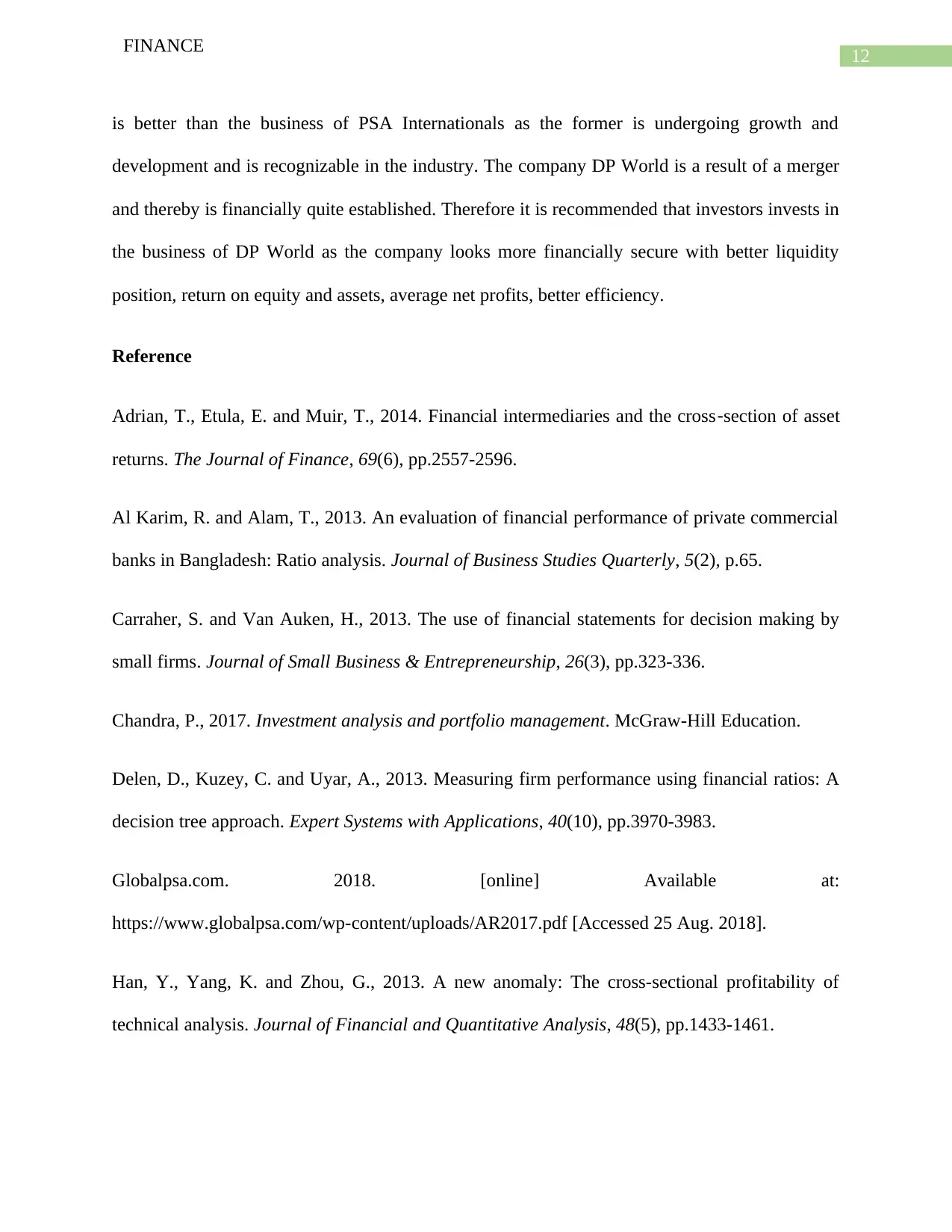
12
FINANCE
is better than the business of PSA Internationals as the former is undergoing growth and
development and is recognizable in the industry. The company DP World is a result of a merger
and thereby is financially quite established. Therefore it is recommended that investors invests in
the business of DP World as the company looks more financially secure with better liquidity
position, return on equity and assets, average net profits, better efficiency.
Reference
Adrian, T., Etula, E. and Muir, T., 2014. Financial intermediaries and the cross‐section of asset
returns. The Journal of Finance, 69(6), pp.2557-2596.
Al Karim, R. and Alam, T., 2013. An evaluation of financial performance of private commercial
banks in Bangladesh: Ratio analysis. Journal of Business Studies Quarterly, 5(2), p.65.
Carraher, S. and Van Auken, H., 2013. The use of financial statements for decision making by
small firms. Journal of Small Business & Entrepreneurship, 26(3), pp.323-336.
Chandra, P., 2017. Investment analysis and portfolio management. McGraw-Hill Education.
Delen, D., Kuzey, C. and Uyar, A., 2013. Measuring firm performance using financial ratios: A
decision tree approach. Expert Systems with Applications, 40(10), pp.3970-3983.
Globalpsa.com. 2018. [online] Available at:
https://www.globalpsa.com/wp-content/uploads/AR2017.pdf [Accessed 25 Aug. 2018].
Han, Y., Yang, K. and Zhou, G., 2013. A new anomaly: The cross-sectional profitability of
technical analysis. Journal of Financial and Quantitative Analysis, 48(5), pp.1433-1461.
FINANCE
is better than the business of PSA Internationals as the former is undergoing growth and
development and is recognizable in the industry. The company DP World is a result of a merger
and thereby is financially quite established. Therefore it is recommended that investors invests in
the business of DP World as the company looks more financially secure with better liquidity
position, return on equity and assets, average net profits, better efficiency.
Reference
Adrian, T., Etula, E. and Muir, T., 2014. Financial intermediaries and the cross‐section of asset
returns. The Journal of Finance, 69(6), pp.2557-2596.
Al Karim, R. and Alam, T., 2013. An evaluation of financial performance of private commercial
banks in Bangladesh: Ratio analysis. Journal of Business Studies Quarterly, 5(2), p.65.
Carraher, S. and Van Auken, H., 2013. The use of financial statements for decision making by
small firms. Journal of Small Business & Entrepreneurship, 26(3), pp.323-336.
Chandra, P., 2017. Investment analysis and portfolio management. McGraw-Hill Education.
Delen, D., Kuzey, C. and Uyar, A., 2013. Measuring firm performance using financial ratios: A
decision tree approach. Expert Systems with Applications, 40(10), pp.3970-3983.
Globalpsa.com. 2018. [online] Available at:
https://www.globalpsa.com/wp-content/uploads/AR2017.pdf [Accessed 25 Aug. 2018].
Han, Y., Yang, K. and Zhou, G., 2013. A new anomaly: The cross-sectional profitability of
technical analysis. Journal of Financial and Quantitative Analysis, 48(5), pp.1433-1461.
Paraphrase This Document
Need a fresh take? Get an instant paraphrase of this document with our AI Paraphraser
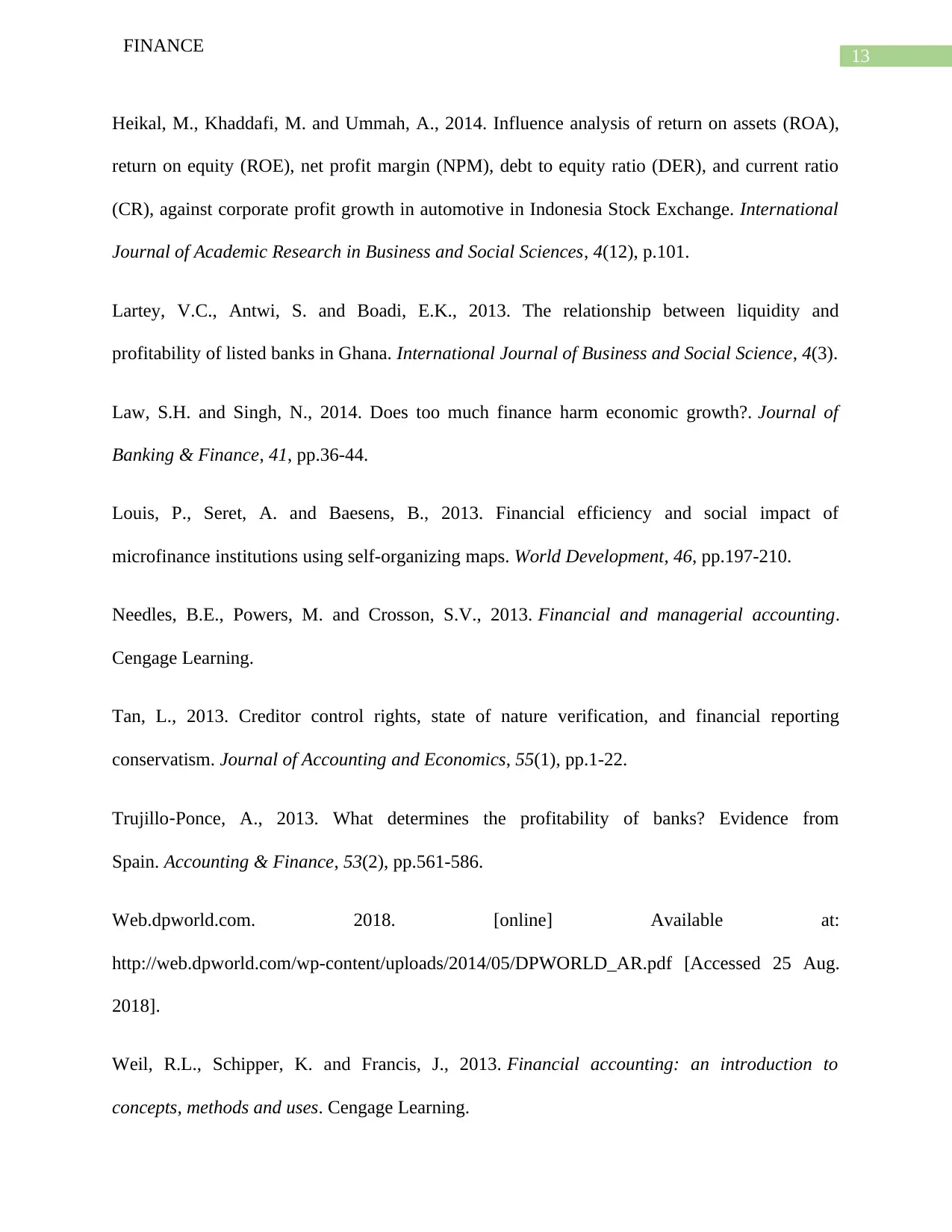
13
FINANCE
Heikal, M., Khaddafi, M. and Ummah, A., 2014. Influence analysis of return on assets (ROA),
return on equity (ROE), net profit margin (NPM), debt to equity ratio (DER), and current ratio
(CR), against corporate profit growth in automotive in Indonesia Stock Exchange. International
Journal of Academic Research in Business and Social Sciences, 4(12), p.101.
Lartey, V.C., Antwi, S. and Boadi, E.K., 2013. The relationship between liquidity and
profitability of listed banks in Ghana. International Journal of Business and Social Science, 4(3).
Law, S.H. and Singh, N., 2014. Does too much finance harm economic growth?. Journal of
Banking & Finance, 41, pp.36-44.
Louis, P., Seret, A. and Baesens, B., 2013. Financial efficiency and social impact of
microfinance institutions using self-organizing maps. World Development, 46, pp.197-210.
Needles, B.E., Powers, M. and Crosson, S.V., 2013. Financial and managerial accounting.
Cengage Learning.
Tan, L., 2013. Creditor control rights, state of nature verification, and financial reporting
conservatism. Journal of Accounting and Economics, 55(1), pp.1-22.
Trujillo‐Ponce, A., 2013. What determines the profitability of banks? Evidence from
Spain. Accounting & Finance, 53(2), pp.561-586.
Web.dpworld.com. 2018. [online] Available at:
http://web.dpworld.com/wp-content/uploads/2014/05/DPWORLD_AR.pdf [Accessed 25 Aug.
2018].
Weil, R.L., Schipper, K. and Francis, J., 2013. Financial accounting: an introduction to
concepts, methods and uses. Cengage Learning.
FINANCE
Heikal, M., Khaddafi, M. and Ummah, A., 2014. Influence analysis of return on assets (ROA),
return on equity (ROE), net profit margin (NPM), debt to equity ratio (DER), and current ratio
(CR), against corporate profit growth in automotive in Indonesia Stock Exchange. International
Journal of Academic Research in Business and Social Sciences, 4(12), p.101.
Lartey, V.C., Antwi, S. and Boadi, E.K., 2013. The relationship between liquidity and
profitability of listed banks in Ghana. International Journal of Business and Social Science, 4(3).
Law, S.H. and Singh, N., 2014. Does too much finance harm economic growth?. Journal of
Banking & Finance, 41, pp.36-44.
Louis, P., Seret, A. and Baesens, B., 2013. Financial efficiency and social impact of
microfinance institutions using self-organizing maps. World Development, 46, pp.197-210.
Needles, B.E., Powers, M. and Crosson, S.V., 2013. Financial and managerial accounting.
Cengage Learning.
Tan, L., 2013. Creditor control rights, state of nature verification, and financial reporting
conservatism. Journal of Accounting and Economics, 55(1), pp.1-22.
Trujillo‐Ponce, A., 2013. What determines the profitability of banks? Evidence from
Spain. Accounting & Finance, 53(2), pp.561-586.
Web.dpworld.com. 2018. [online] Available at:
http://web.dpworld.com/wp-content/uploads/2014/05/DPWORLD_AR.pdf [Accessed 25 Aug.
2018].
Weil, R.L., Schipper, K. and Francis, J., 2013. Financial accounting: an introduction to
concepts, methods and uses. Cengage Learning.
1 out of 14
Related Documents
Your All-in-One AI-Powered Toolkit for Academic Success.
+13062052269
info@desklib.com
Available 24*7 on WhatsApp / Email
![[object Object]](/_next/static/media/star-bottom.7253800d.svg)
Unlock your academic potential
© 2024 | Zucol Services PVT LTD | All rights reserved.





